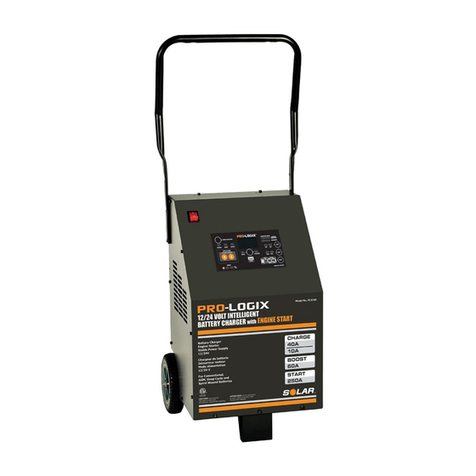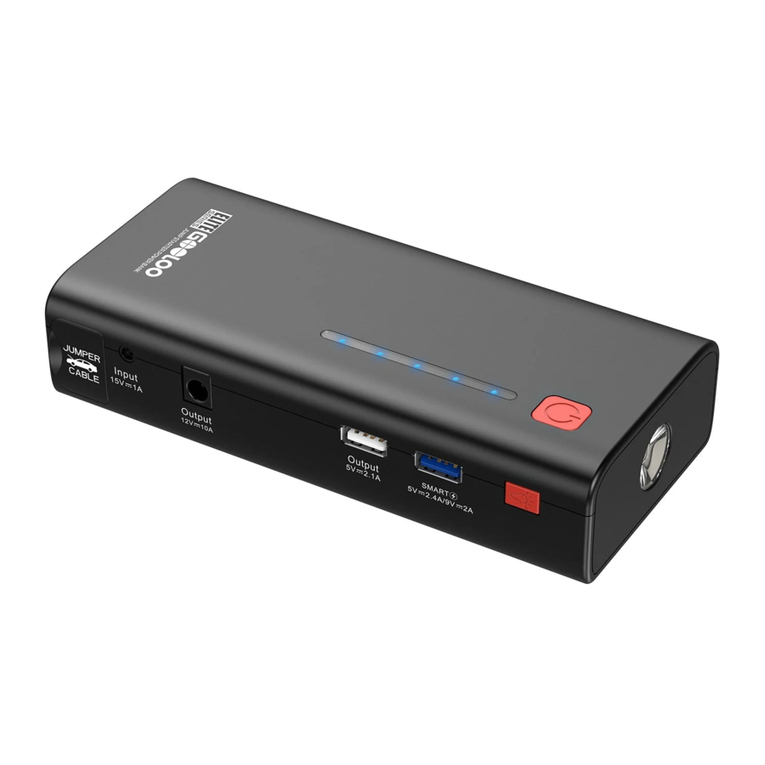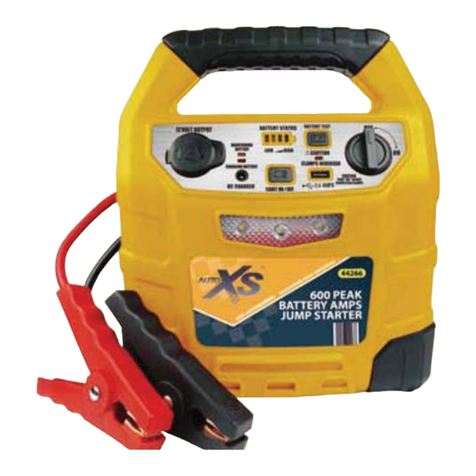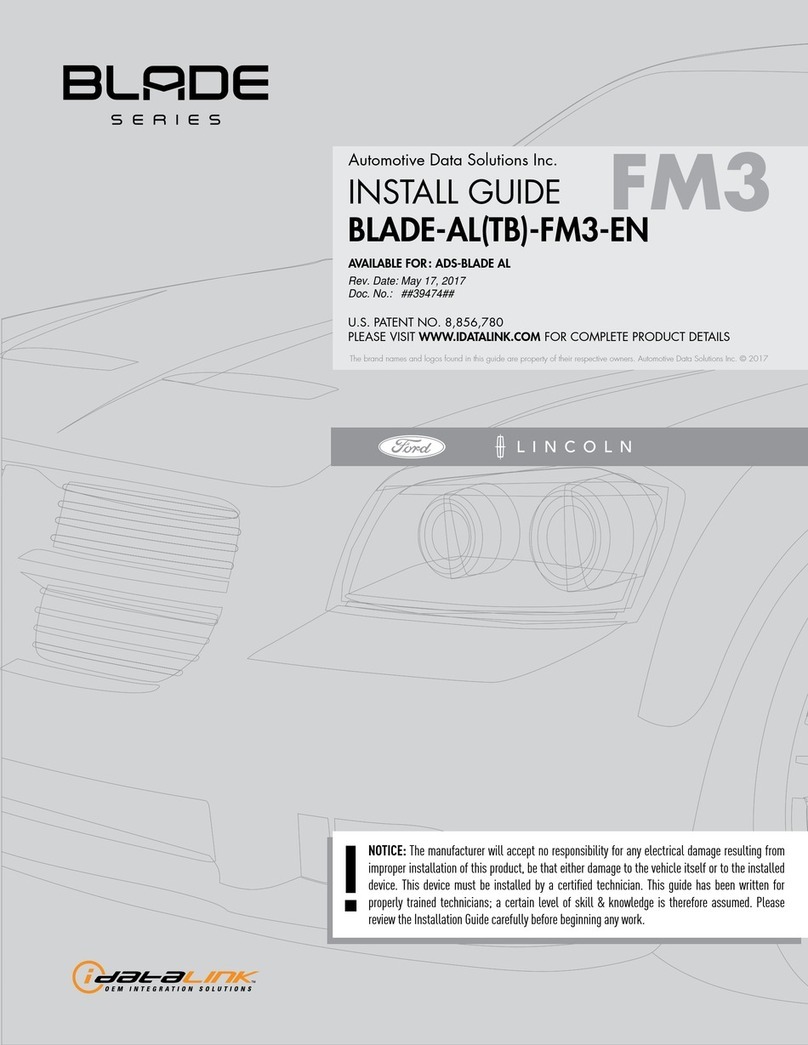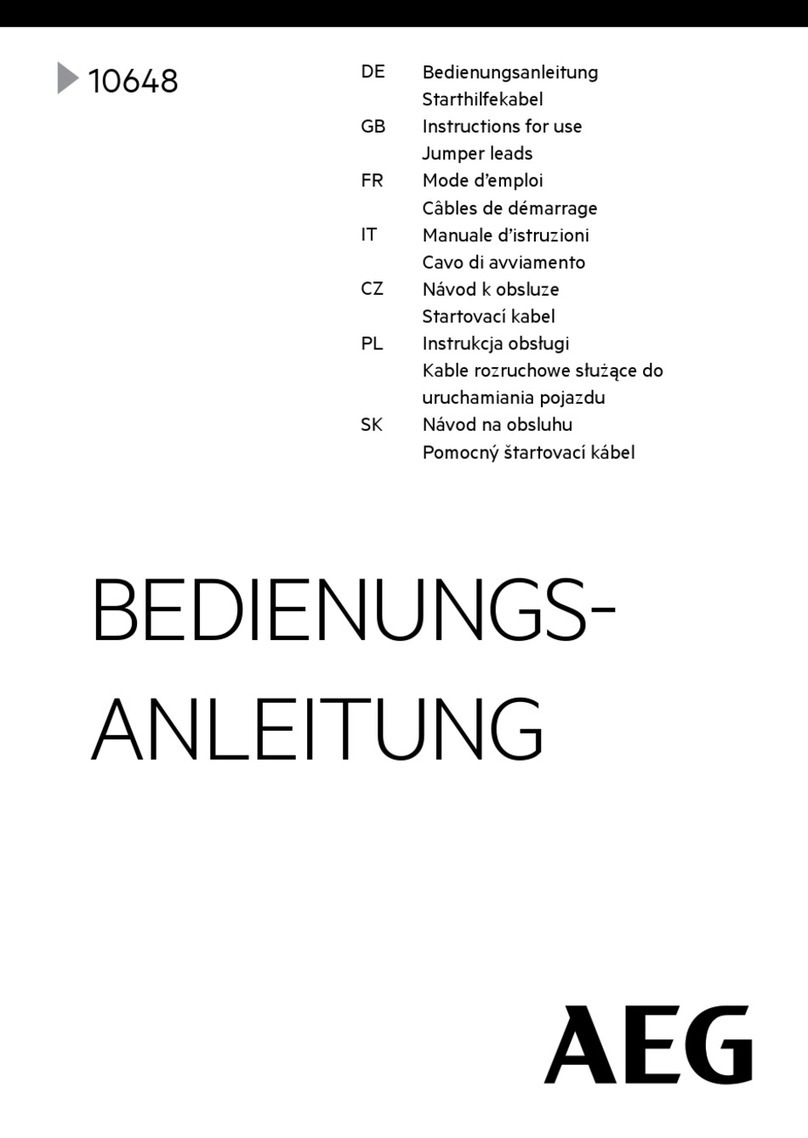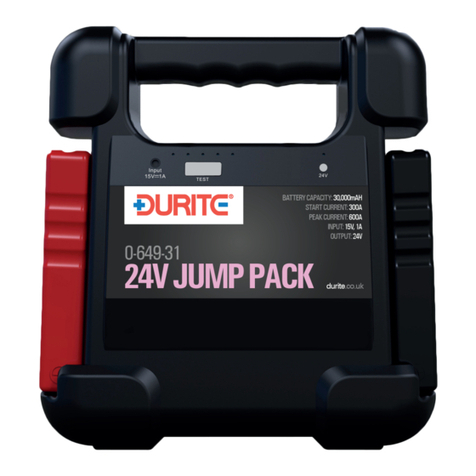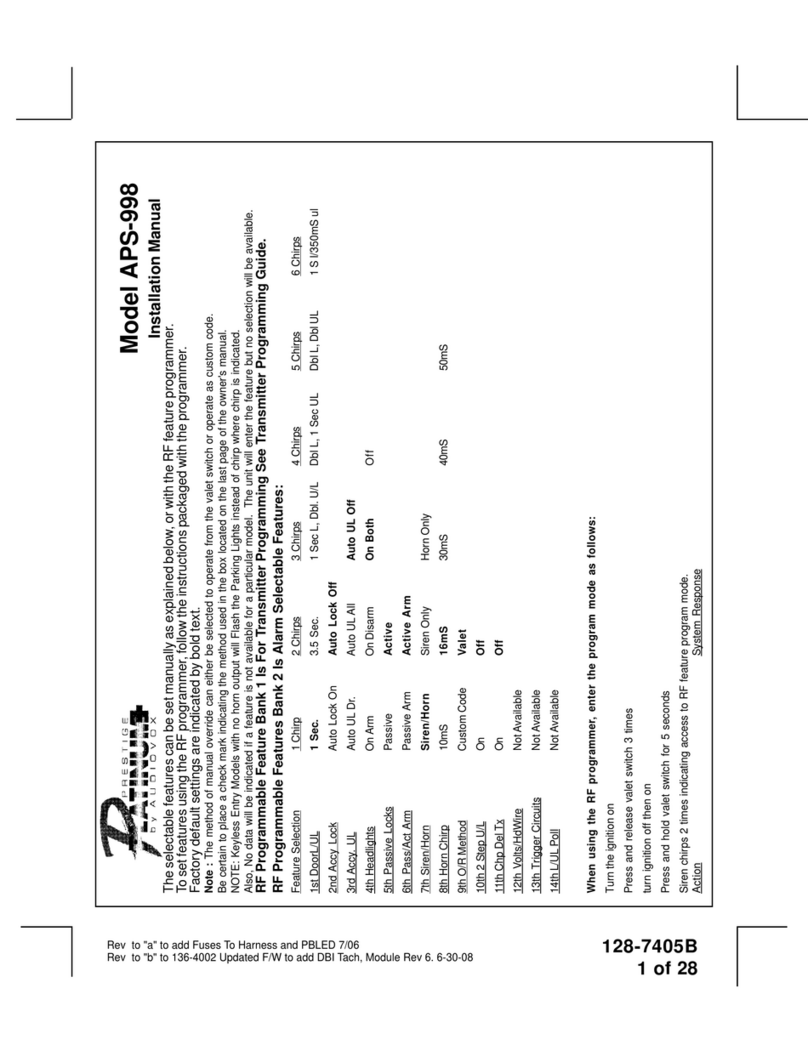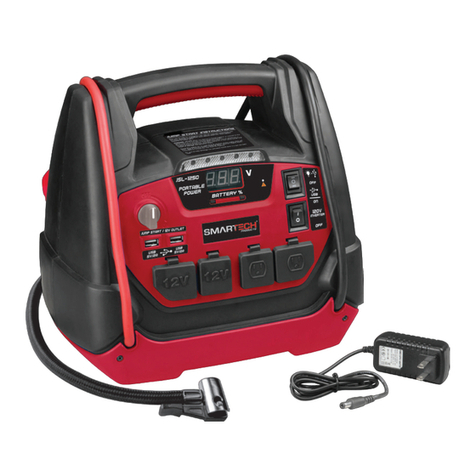Prologix PL2112 User manual

Failure to follow instructions may cause
damage or explosion, always shield eyes.
Read entire instruction manual before use.
WARNING
Manual
Battery Maintainer Model No. PL2112
No. 141-112-000
This product can expose you to chemicals, including
Vinyl-Chloride, Styrene and Acrylonitrile, which are
known to the State of California to cause cancer.
WARNING

2
IMPORTANT SAFETY INSTRUCTIONS - READ THESE FIRST
A
WARNING
Read these instructions completely before using the Battery Charger and save them for future
reference. Before using the Battery Charger to charge a battery, read these instructions and the
instruction manual/safety information provided by the car, truck, boat or equipment manufacturer.
Following all manufacturers’ instructions and safety procedures will reduce the risk of accident.
Working around lead-acid batteries may be dangerous. Lead-acid batteries release explosive gases
during normal operation, charging and jump starting. Carefully read and follow these instructions for
safe use. Always follow the specific instructions in this manual and on the Battery Charger each time
you use the Battery Charger.
All lead-acid batteries (car, truck and boat) produce hydrogen gas which may violently explode in the
presence of fire or sparks. Do not smoke, use matches or a cigarette lighter while near
batteries. Do not handle the battery while wearing vinyl clothing because static electricity sparks are
generated when vinyl clothing is rubbed. Review all cautionary material on the Battery Charger and
in the engine compartment.
This battery charger is equipped with a setting for charging a specific type of lithium battery
chemistry, Lithium Iron Phosphate (LiFePO4). The charger's lithium charging function is optimized
for this type of lithium battery only, as noted on the control panel. There exist many different lithium
battery types, each using a different specific lithium battery chemistry. Do not charge any other
lithium battery types using this charger – doing so could result in personal injury and/or property
damage.
Always wear eye protection, appropriate protective clothing and other safety equipment when
working near lead-acid batteries. Do not touch eyes while working on or around lead-acid batteries.
Always store clamps away from each other or common conductors. Improper storage of clamps may
cause the clamps to come in contact with each other, or a common conductor, which would be
hazardous if the Battery Charger was plugged into an AC outlet.
Use extreme care while working within the engine compartment, because moving parts may cause
severe injury. Read and follow all safety instructions published in the vehicle's Owner's Manual.
Batteries being charged with the Battery Charger unit likely contain liquid acids which are hazardous
if spilled.
WARNING: Changes or modifications to this unit not expressly approved by the party responsible for compliance
could void the user’s authority to operate the equipment.
NOTE: This equipment has been tested and found to comply with the limits for a Class B digital device, pursuant to
Part 15 of the FCC Rules. These limits are designed to provide reasonable protection against harmful interference in
a residential installation. This equipment generates, uses and can radiate radio frequency energy and, if not installed
and used in accordance with the instructions, may cause harmful interference to radio communications. However,
there is no guarantee that interference will not occur in a particular installation. If this equipment does cause harmful
interference to radio or television reception, which can be determined by turning the equipment off and on, the user is
encouraged to try to correct the interference by one or more of the following measures:
- Reorient or relocate the receiver antenna.
- Increase the separation between remote and receiver.
- Connect the equipment into an outlet on a circuit different from that to which the receiver is connected.
- Consult the dealer or an experienced radio TV technician for help.
This Class B digital apparatus complies with Canadian ICES-003.

3
1. SAVE THESE INSTRUCTIONS – This manual
contains important safety and operating instructions
for Model No. PL2112.
2. Do not expose charger to rain or snow.
3. Use of an attachment not recommended or sold by the
manufacturer may result in a risk of fire, electric shock,
or injury to persons.
4. To reduce risk of damage to electric plug and cord,
pull by plug rather than cord when disconnecting
charger.
5. An extension cord should not be used unless
absolutely necessary. Use of an improper extension
cord could result in a risk of fire and electric shock. If
extension cord must be used, make sure:
a. That pins on plug of extension cord are the same
number, size, and shape as those of plug on
charger,
b. That extension cord is properly wired and in good
electrical condition; and
c. That the wire size is large enough for the length of
cord as specified below.
6. DANGER – FIRE HAZARD
When you connect the positive clamp to the battery
positive terminal, take care to avoid it coming into
accidental contact with the engine, frame or any other
grounded component. This will cause a short circuit
from the battery positive through the vehicle’s ground
to the battery negative, potentially causing a fire risk,
engine component damage, and / or physical harm to
the user.
7. To prevent electric shock - Dispose of battery charger
if cord becomes defective.
8. Do not operate charger if it has received a sharp blow,
been dropped, or otherwise damaged in any way; take
it to a qualified service center.
9. Do not disassemble charger; take it to a qualified
service center when service or repair is required.
Incorrect reassembly may result in a risk of electric
shock or fire.
10. To reduce risk of electric shock, unplug the charger
from outlet before attempting any maintenance or
cleaning. Turning off controls will not reduce this risk.
11. Monitor battery charger daily when using it to maintain
battery for extended periods.
12. WARNING – RISK OF EXPLOSIVE GASES.
a. Working in vicinity of a lead-acid battery is
dangerous. Batteries generate explosive gases
during normal battery operation. For this reason, it
is of utmost importance that each time before using
your charger, you read this manual and follow the
instructions exactly.
b. To reduce risk of battery explosion, follow these
instructions and those published by the battery
manufacturer and the manufacturer of any
equipment you intend to use in the vicinity of the
battery. Review cautionary markings on these
products and in the engine compartment.
1. Someone should be within range of your voice or
close enough to come to your aid when you work near
a lead-acid battery.
2. Have plenty of fresh water and soap nearby in case
battery acid contacts skin, clothing, or eyes.
3. Wear complete eye protection and clothing protection.
Avoid touching eyes while working near battery.
4. If battery acid contacts skin or clothing, wash
immediately with soap and water. If acid enters
eye, immediately flood eye with cold running water
for at least 10 minutes and get medical attention
immediately.
5. NEVER smoke or allow a spark or flame in vicinity of
battery or engine.
6. Be extra cautious to reduce risk of dropping a metal
tool onto battery. It might spark or short-circuit battery
or other electrical part that may cause explosion.
7. Remove personal metal items such as rings,
bracelets, necklaces, and watches when working with
a lead-acid battery. A lead-acid battery can produce
a short-circuit current high enough to weld a ring or
other jewelry to metal, causing a severe burn.
8. Use charger for charging LEAD-ACID and LiFePO4
batteries only. It is not intended to supply power to a
low voltage electrical system other than in a starter-
motor application. Do not use battery charger for
charging dry-cell batteries that are commonly used
with home appliances. These batteries may burst and
cause injury to persons and damage to property.
9. NEVER charge a frozen battery.
PERSONAL PRECAUTIONS
B
Cord Length: ft.(m) 25(8) 50(16) 100(31) 150(46)
AWG size of cord: 18 16 14 12

4
1. CAUTION: Connect and disconnect DC output clips only after ensuring the unit is in IDLE mode and removing AC
power cord from electric outlet. Never allow clips to touch each other.
2. When hooking up charger, attach one clip to battery and the other to a point away from battery (see sections F & G).
Do not hook up charger until reading sections A–J.
3. Always make battery connections prior to plugging charger into AC outlet.
To reduce explosion risk, never connect both clips directly to the battery. When making each connection, twist or rock clip
back and forth several times to make a good connection and to reduce the risk of a clip slipping off and creating a spark.
Do not twist or rock clip on the battery after the second clip connection is made.
BATTERY CHARGER CONNECTION PRECAUTIONS
E
1. Locate the charger as far away from the battery as DC
cables permit.
2. Never place the charger directly above the battery
being charged; gases from the battery will corrode and
damage the charger.
3. Never allow battery acid to drip on the charger when
reading specific gravity or filling the battery.
4. Do not operate the charger in a closed area or restrict
ventilation in any way.
5. Do not set a battery on top of the charger.
6. Locate the charger at least 18” above the floor.
7. Do not place the charger where rain, snow, or other
moisture could drip on it.
LOCATING THE CHARGER
D
PREPARATION
C
PREPARING TO CHARGE BATTERY:
1. If it is necessary to remove battery from vehicle to
charge, always remove grounded terminal from battery
first. Make sure all accessories in the vehicle are off,
so as not to cause an arc.
2. Be sure area around battery is well ventilated while
battery is being charged. Gas can be forcefully blown
away by using a piece of cardboard or other non-
metallic material as a fan.
3. Clean battery terminals with a mixture of baking soda
and hot water. Be careful to keep corrosion from
coming in contact with eyes.
4. Add distilled water in each cell until battery acid
reaches level specified by battery manufacturer. This
helps purge excessive gas from cells. Do not overfill.
For Maintenance Free Batteries - carefully follow
manufacturer’s recharging instructions.
5. Study all battery manufacturer’s specific precautions
such as removing or not removing cell caps while
charging and recommended rates of charge.
6. Determine voltage of battery by referring to vehicle
owner’s manual and make sure that charger output
voltage matches vehicle voltage.

5
CAUTION: A MARINE (BOAT) BATTERY MUST BE
REMOVED AND CHARGED ON SHORE. TO CHARGE
IT ON BOARD REQUIRES EQUIPMENT SPECIALLY
DESIGNED FOR MARINE USE.
CAUTION: A SPARK NEAR BATTERY MAY CAUSE
BATTERY EXPLOSION. TO REDUCE RISK OF A
SPARK NEAR BATTERY:
1. Check polarity of battery posts. POSITIVE (POS, P,
+) battery post usually has a larger diameter than
NEGATIVE (NEG, N, –) post.
2. Attach at least a 24” long, #6 gauge (AWG) insulated
battery cable to NEGATIVE (Neg, N, –) battery post.
3. Connect POSITIVE (RED) charger clip to POSITIVE
(POS, P, +) post of battery.
4. Position yourself and the free end of the cable
(installed in step #2) as FAR away from the battery
as possible. FACING AWAY FROM THE BATTERY,
connect the NEGATIVE (Black) charger clip to the free
end of the cable.
5. When charging is complete, turn charging sequence
off by depressing the “CHARGE” button. Then
disconnect charger, always in reverse sequence of
connecting procedure and break first connection while
as far away from battery as practical.
CHARGING A BATTERY OUTSIDE OF THE VEHICLE
G
CAUTION: A MARINE (BOAT) BATTERY MUST BE REMOVED AND CHARGED ON SHORE. TO CHARGE IT ON
BOARD REQUIRES EQUIPMENT SPECIALLY DESIGNED FOR MARINE USE.
CAUTION: A SPARK NEAR BATTERY MAY CAUSE BATTERY EXPLOSION. TO REDUCE RISK OF A SPARK NEAR
BATTERY:
1. Position AC and DC cords to reduce risk of damage by hood, door, or moving engine part.
2. Stay clear of fan blades, belts, pulleys, and other parts that can cause injury to persons.
3. Check polarity of battery posts. POSITIVE
(POS, P, +) battery post usually has larger diameter than NEGATIVE (NEG, N, –) post.
4. Determine which post of battery is grounded (connected) to the chassis. If the negative post is grounded to the
chassis (as in most vehicles), see Figure 1 and instruction 5a. If the positive post is grounded to the chassis, see
instruction 5b.
5. a) For NEGATIVE GROUNDED vehicle, connect POSITIVE (Red) clip from the battery charger to the POSITIVE
(POS, P, +) ungrounded post of the battery.
b) For POSITIVE GROUNDED vehicle, connect the NEGATIVE (Black) clip from the
battery charger to the NEGATIVE (NEG, N, –) ungrounded post of the battery. (This
arrangement is usually found in pre-1970 foreign vehicles or pre-1970 farm tractors.
This is a rare occurrence.)
6. Connect the remaining battery charger clip to the vehicle chassis or engine block, as far
away from the battery as possible. Do not connect the clip to carburetor, fuel lines, or
sheet metal body parts. Connect to a heavy gauge metal part of the frame or engine
block.
7. When disconnecting charger, turn charging sequence OFF by depressing the
“CHARGE” button, disconnect AC cord, remove clip from vehicle chassis, and then
remove clip from battery terminal.
8. Refer to the Operating Instructions for information on setting selector switches.
CHARGING A BATTERY THAT IS INSTALLED IN A VEHICLE
F
Negative to
Chassis Ground
Positive
Figure 1
++__
Cable
from
Charger Cable from
Charger
Positive Booster
Cable Negative

6
BATTERY CHARGING SETTINGS
Upon making a proper battery connection (see Section
F or G as applicable), plug AC power cord into an AC
receptacle. All unit LEDs will light momentarily, then only
the LEDs corresponding to charging settings should stay
lit. The charger is now in Standby Mode.
If an ERROR Indicator LED lights, disconnect from AC
power supply immediately and determine the cause of the
alarm. A flashing ERROR light indicates reverse polarity,
while a solid ERROR light indicates the detection of a
battery fault, such as a shorted connection.
To charge a battery:
1. Choose a battery type setting. To charge Standard
and Maintenance Free Flooded Acid batteries, push
the Battery Type button until the “STD” LED is lit. To
charge AGM and Spiral Wound batteries, push the
Battery Type button until the “AGM” LED is lit. To
charge Lithium Iron Phosphate starting batteries, push
the Battery Type button until the “LiFeP04” LED is lit.
Note: When charging lithium batteries, please
note that there are many different lithium battery
chemistries. The Lithium charging setting on this
charger is specifically for Lithium Iron Phosphate
(LiFePO4) batteries and only these lithium batteries.
The charger should never be used for charging any
other lithium battery type.
Note: Ambient temperature must be between 0C and
50C in order to charge a LiFePO4 battery. If ambient
temperature is outside this range, ERROR is solid and
LiFePO4 is flashing, and charging will not start.
2. Press the “CHARGE” button and the charging
indicator LED will light. The charger will automatically
commence and complete the charging process. If you
press the “CHARGE” button at any point during the
charging sequence, the charger will stop charging and
return to Standby Mode.
Note: If the ERROR LED lights, disconnect from AC
power immediately and determine the cause of the
alarm. See Additional Features for a list of conditions
that might cause this warning.
Note: The charger is designed to protect against faults
and shorts (see Battery Charger Features). If the
battery to be charged has an open circuit voltage of
less than 1V, the charger will indicate a fault. If, after
unplugging unit, checking connections and verifying
all settings, you determine the problem causing the
“fault” condition is battery voltage below 1V, you can
override the charger’s protection by holding down the
“CHARGE” button for 3 seconds. The charger will
commence the charging sequence and, assuming
there are no other hindrances that caused the fault
indication, will complete the charging process and
automatically turn off when the battery has reached
full charge.
3. When the battery approaches full charge and enters
the Completion Phase, the green CHARGING
COMPLETE indicator will light and the CHARGING IN
PROGRESS indicator will flash. At this point, if time
is critical, the battery can be put into service if it will be
used in a charging situation, such as in a vehicle that
that will be used immediately. To reach a true 100%
state of charge, the charger should stay connected
until the charger reaches the Rest Phase, when only
the green CHARGING COMPLETE is lit.
4. When you are finished with the charging process,
disconnect AC power cord from AC outlet, then
disconnect DC leads from vehicle ground (if charging
with battery in vehicle) and battery in the reverse
sequence of the connection procedure.
Low Energy Consumption Mode
Note: The charger is designed to minimize energy
consumption as much as possible. If the unit is in
standby mode for 10+ minutes without a key pressed,
the TYPE LED will flash. If the unit is in charge mode
and has reached the rest phase, the CHARGED
LED will flash slowly. At any time, you can wake the
display by pressing any button.
OPERATING INSTRUCTIONS
H
Battery Type LEDs
Charging Fully Charged Error
Battery Type Button
Start Charging Button

7
CHARGING PROGRESS AND DISPLAY FEEDBACK
The charger uses a proprietary Multi-Stage charging process designed to optimally charge and maintain batteries.
Assuming normal battery health, the standard charging sequence has four stages: 1.) energizing, 2.) fast charge, 3.)
absorption, 4.) completion. Additionally, the charger has dedicated modes to address battery issues, as noted below.
Finally your charger is an ideal tool for battery maintenance, the steps for which are addressed below as phases 5-7.
ENERGIZING PHASE
The charging process includes an initial energizing mode in which the charger determines the best charging path for
the connected battery. From there, the charger can enter the Fast Charge stage (most cases), Soft Start Mode, Battery
Recondition Mode or stop the charging routine because unsafe battery conditions (short, etc.) are detected.
SOFT START MODE
Soft Start Mode is activated when the charger is connected to a deeply discharged battery. This mode protects the battery
during the initial charge period, as the battery’s voltage rises to a more normal level, and is beneficial for the long-term
health of the battery.
BATTERY RECONDITION MODE
During the Energizing Phase, if the charger detects the presence of battery sulfation, it will activate this mode. If this
occurs, the CHARGING LED will flash. This indicates the charge time will be extended while the charger attempts to
recondition the battery.
PRO-LOGIX PHASES 5-7: IDEAL BATTERY MAINTENANCE
A key feature of this charger is how it manages a battery that remains on the charger after a complete charge has been
achieved, such as during the storage of a seasonal use vehicle. Once the charger reaches the Resting Phase, its output
is virtually turned off, except to occasionally monitor battery condition. This is beneficial for the connected battery, as it
reduces chemical reaction within the battery compared to traditional charger maintenance modes. This greatly reduces the
chance of damaging a battery in long-term storage. In the resting phase, the charger will enter a low power mode, when
only the green “Complete” LED flashes slowly. To resume normal operation, press any key to reactivate the display.
In addition, in Phase 6 Exercising, we introduce a load on the battery, simulating active use, and then recharge the battery
to full charge. This Exercising feature keeps the battery in optimal condition during periods of storage and non-use.
ADDITIONAL FEATURES
MULTIPLE BATTERY COMPATIBILITY
The charger will properly charge a wide variety of battery types, including Conventional, Maintenance Free,
AGM, LiFe, Spiral Wound and Deep Cycle batteries.
SMART CLAMP TECHNOLOGY
The charger will send power to the output leads only when a proper battery connection is made.
REVERSE POLARITY PROTECTION
Guards against reverse connections. The ERROR LED will flash on the control panel and power will not be sent to output
cables if a reverse connection is sensed.
TEMPERATURE COMPENSATION
The charger is equipped with temperature compensation technology, which alters the charging parameters based on
ambient temperature. This is beneficial for battery health, as it is critical in achieving an optimal charge, as the battery’s
needs change based on temperature.
BATTERY FAULT PROTECTION
Guards against excessively charging compromised batteries. ERROR and CHARGING LED will flash indicating charging
has stopped and the charger has detected a compromised battery. Conditions that cause this error include: if the battery
voltage does not rise appropriately during the charging process (indicating a shorted cell) or if the maximum charge time
has been exceeded.
SHORT CIRCUIT PROTECTION
Guards against shorted connections. ERROR LED will light solid on control panel and power will not be sent to output
cables. This condition is triggered if the charger detects less than 1V across the clamps. See Operating Instructions Step
2 Note 2 for details regarding this feature.

CAUTION – Make sure charger is unplugged from
electrical outlet before performing any maintenance.
A minimum amount of care can keep your battery charger
working and looking good for years.
1. Clean the clamps after each use. Wipe off any battery
fluid that may have come in contact with the clamps
to prevent corrosion. Battery fluid may be neutralized
with a solution of water and baking soda.
2. If needed, the case may be wiped clean with a soft
cloth.
There are no user-serviceable parts inside.
CHARGER CARE & MAINTENANCE
J
CHOOSING THE BATTERY TYPE
I
OVER-VOLTAGE PROTECTION
Guards against charging errors where the charger is programmed to charge in a different voltage than the detected
voltage of the battery. When this safeguard is engaged, the ERROR LED will slowly flash (2.0s-ON/2.0s-OFF). To reset
the charger, disconnect from AC outlet, reset the vehicle connections and reconnect to the AC outlet.
For Conventional and Maintenance Free flooded (wet) batteries, the ideal Battery Type selection is “STD”.
For batteries identified as AGM construction, the ideal Battery Type selection is “AGM”.
For batteries identified as LiFe construction, the ideal Battery Type selection is “LiFeP04”.
For most Spiral Wound batteries, the best Battery Type selection is “AGM”.
For batteries identified as Deep Cycle, determine the construction of the battery. Is it a wet cell battery or another type of
construction? This will determine the proper Battery Type selection.
For batteries identified as Marine, determine the construction of the battery. Is it a wet cell battery or another type of
construction? This will determine the proper Battery Type selection.
View other battery chargers and jump starters made by Solar on our website.
This manual suits for next models
1
Table of contents
Other Prologix Remote Starter manuals
Popular Remote Starter manuals by other brands
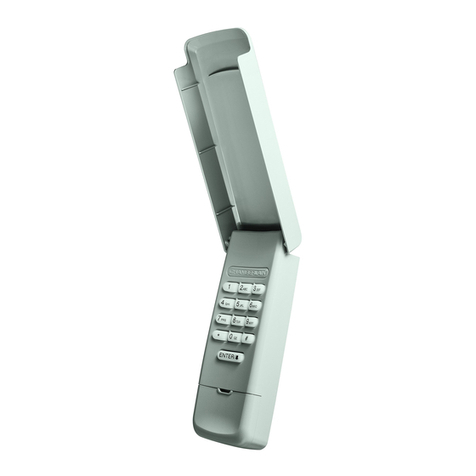
Chamberlain
Chamberlain 940EV manual
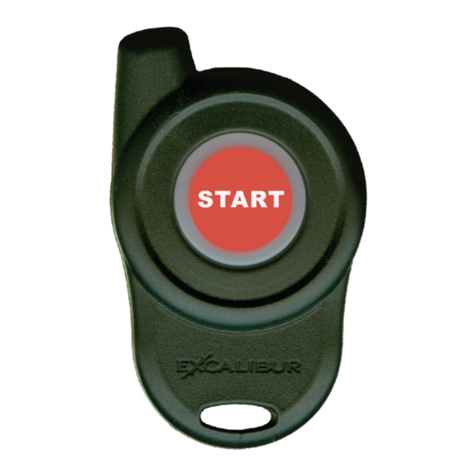
Excalibur
Excalibur RS-250-DP Operation guide
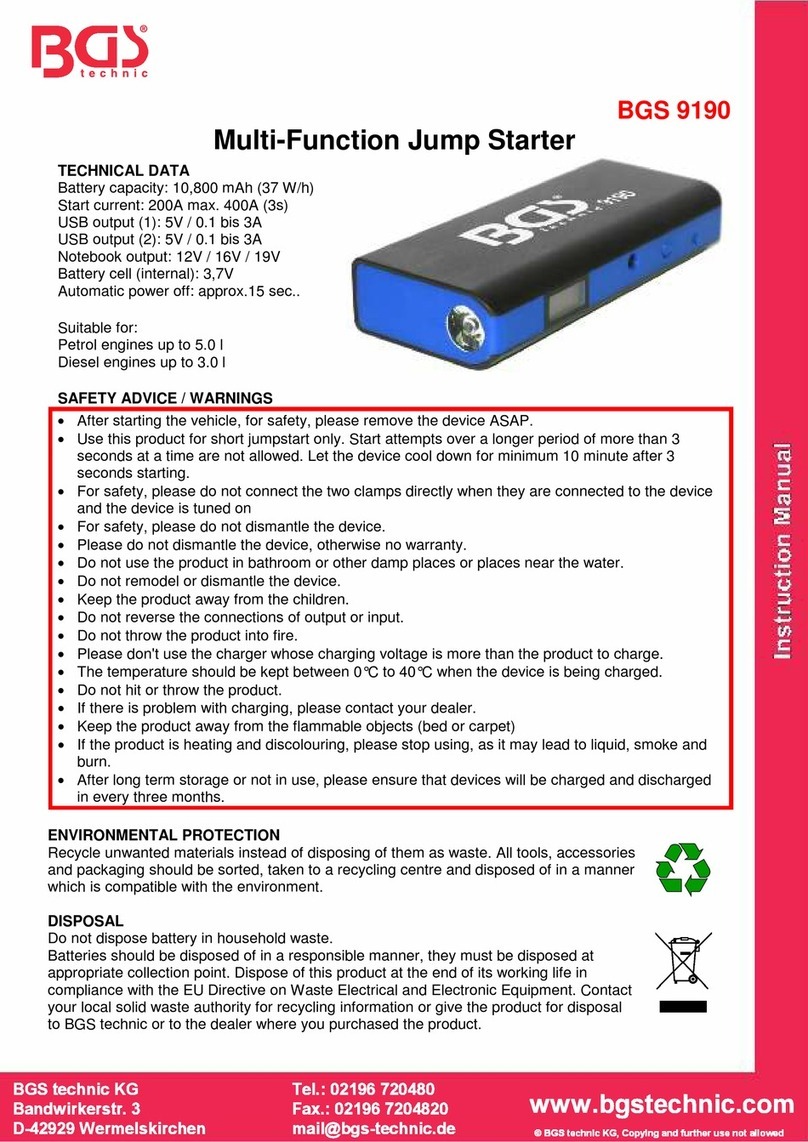
BGS technic
BGS technic 9190 instruction manual
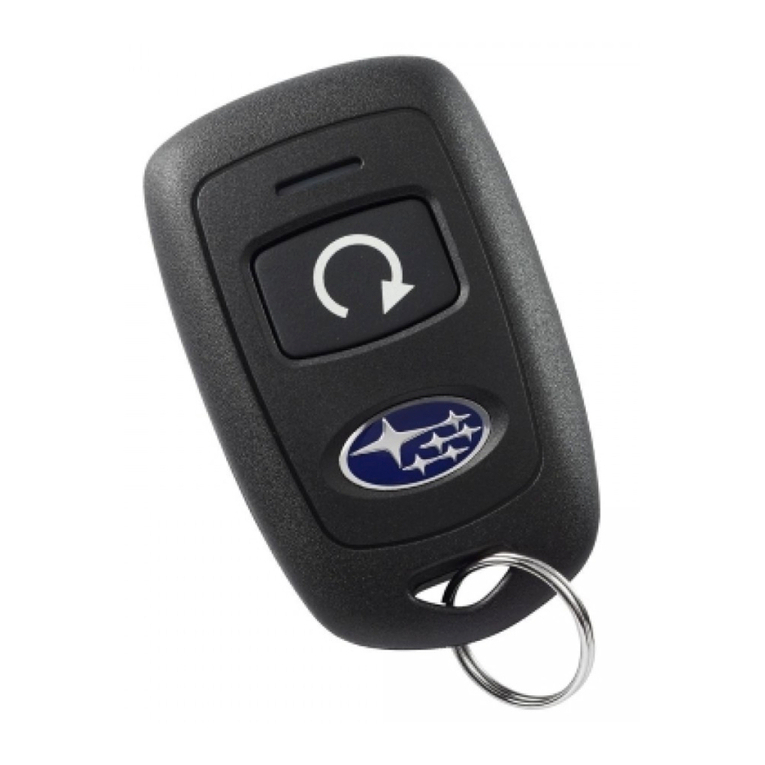
Subaru
Subaru Remote Start Quick Reference Instruction Manual
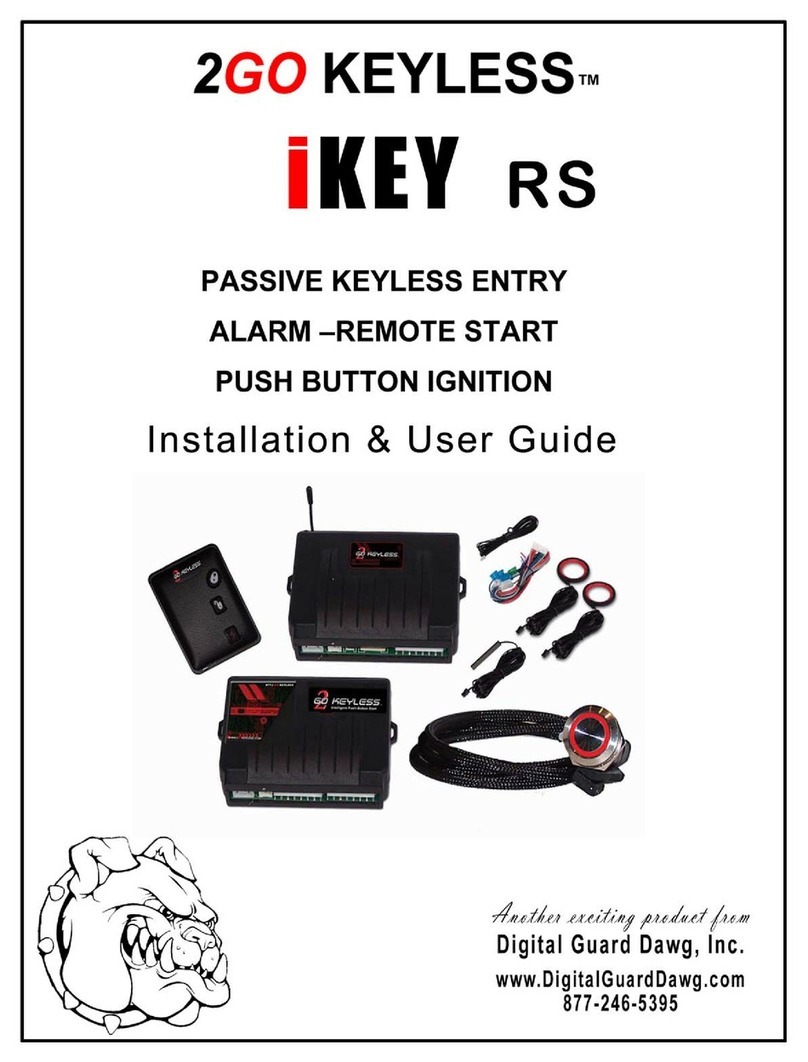
Digital Guard Dawg
Digital Guard Dawg 2GO KEYLESS iKEY RS Installation & user guide
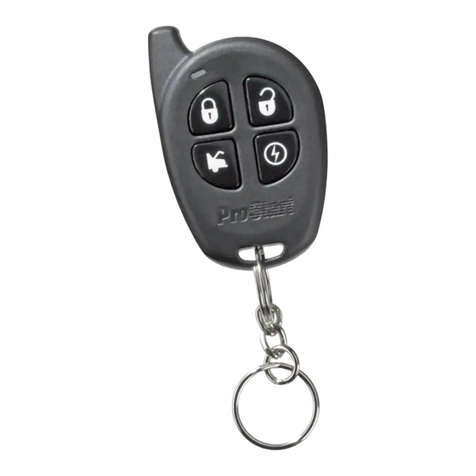
ProStart
ProStart ProStart CT-3360 user guide
